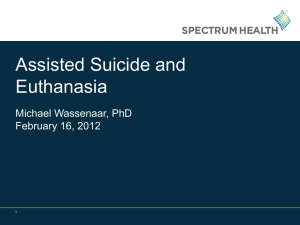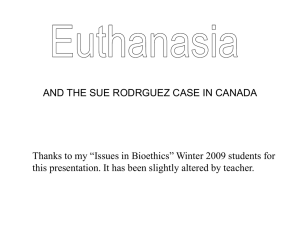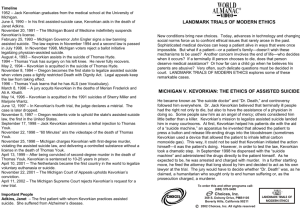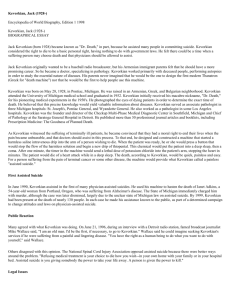Robinson Maddie Robinson Dr. Christina Wright English 1102 26
advertisement
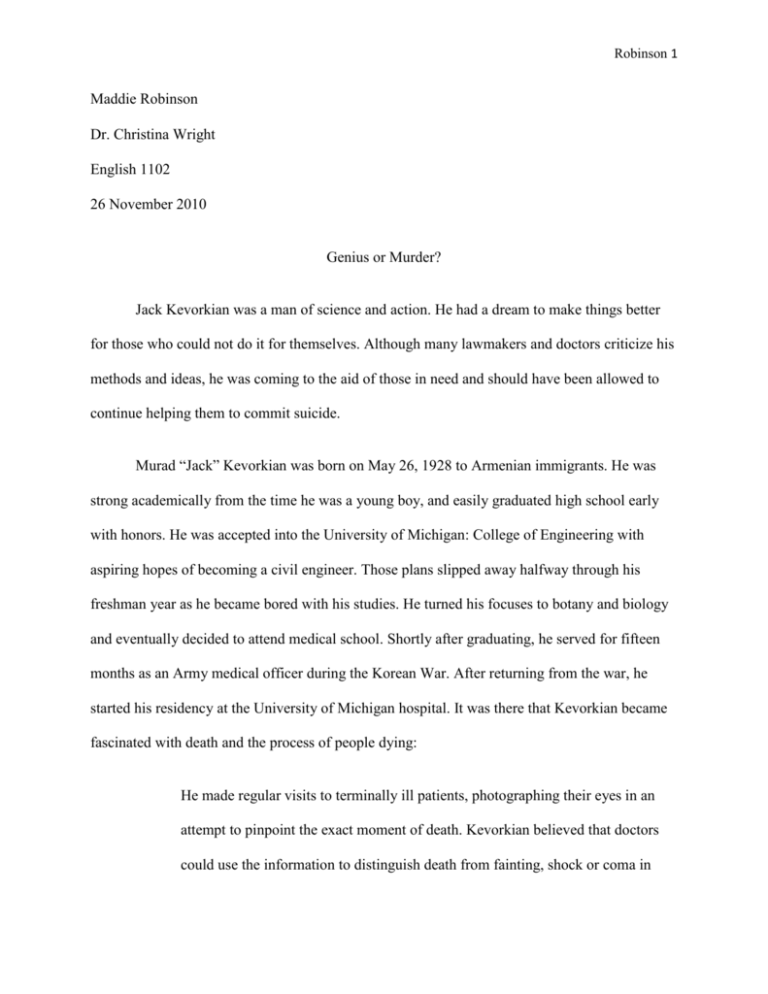
Robinson 1 Maddie Robinson Dr. Christina Wright English 1102 26 November 2010 Genius or Murder? Jack Kevorkian was a man of science and action. He had a dream to make things better for those who could not do it for themselves. Although many lawmakers and doctors criticize his methods and ideas, he was coming to the aid of those in need and should have been allowed to continue helping them to commit suicide. Murad “Jack” Kevorkian was born on May 26, 1928 to Armenian immigrants. He was strong academically from the time he was a young boy, and easily graduated high school early with honors. He was accepted into the University of Michigan: College of Engineering with aspiring hopes of becoming a civil engineer. Those plans slipped away halfway through his freshman year as he became bored with his studies. He turned his focuses to botany and biology and eventually decided to attend medical school. Shortly after graduating, he served for fifteen months as an Army medical officer during the Korean War. After returning from the war, he started his residency at the University of Michigan hospital. It was there that Kevorkian became fascinated with death and the process of people dying: He made regular visits to terminally ill patients, photographing their eyes in an attempt to pinpoint the exact moment of death. Kevorkian believed that doctors could use the information to distinguish death from fainting, shock or coma in Robinson 2 order to learn when resuscitation was useless. "But really, my number one reason was because it was interesting," Kevorkian told reporters later. "And my second reason was because it was a taboo subject." (A&E Television) Soon thereafter he began to propose that death-row prisoners could be used for the testing of medical experiments while they were still alive. These controversial views earned him the name of “Dr. Death” and his expulsion from the University of Michigan Medical Center: He continued his internship at Pontiac General Hospital instead, where he began another set of controversial experiments. After hearing about a Russian medical team who was transfusing blood from corpses into living patients, Kevorkian enlisted the help of medical technologist Neal Nicol to simulate these same experiments. The results were highly successful, and Kevorkian believed the procedure could help save lives on the battlefield—if blood from a bank was unavailable, doctors might use Kevorkian's research to transfuse the blood of corpse into an injured soldier. Kevorkian pitched his idea to the Pentagon, figuring it could be used in Vietnam, but the doctor was denied a federal grant to continue his research. Instead, the research fueled his reputation as an outsider, scared his colleagues and eventually infected Kevorkian with Hepatitis C. (A&E Television) He went around from place to place for a few years trying to publish his research and working under other pathologists. In 1986, he found another way for his research to be accepted by the medical community. He learned about doctors in the Netherlands who were helping people to die Robinson 3 through lethal injection. His new crusade for assisted suicide became an extension of his campaign for medical experiments on those facing death. Assisted suicide or euthanasia is the process of how a doctor helps a terminally ill person to die. One way to distinguish the difference between the two is to look at the last act, the act without which death would not occur. If a third party performs the last act that intentionally causes a patient's death, euthanasia has occurred. For example, giving a patient a lethal injection or putting a plastic bag over her head to suffocate her would be considered euthanasia. On the other hand, if the person who dies performs the last act, assisted suicide has taken place. Thus it would be assisted suicide if a person swallows an overdose of drugs that has been provided by a doctor for the purpose of causing death. It would also be assisted suicide if a patient pushes a switch to trigger a fatal injection after the doctor has inserted an intravenous needle into the patient's vein. Many controversies surround this practice. The question that arises from those against the practice is “If assisted suicide is allowed on the basis of mercy or compassion, what will keep us from “assisting in” and perhaps actively urging the death of anyone whose life we deem worthless or undesirable?”(Andre) Those for the practice argue that everyone has the right to choose life or death, and as long as they do not inflict harm on others then it should not be against the law. Furthermore, it is also argued we have an obligation to relieve the suffering of those in pain and to respect their dignity. It is seen as cruel and inhumane to refuse those people in pain. In the United States, thirty-four states have statutes explicitly criminalizing assisted suicide. Nine states criminalize assisted suicide through common law. North Carolina, Utah, and Wyoming have abolished the common law of crimes and do not have statutes criminalizing it. Robinson 4 Virginia does not have a clear case law and there is not a statute criminalizing the act, but there is a statute which imposes civil sanctions against those assisting in a suicide. Ohio ruled in October of 1996 that assisted suicide is not a crime. Oregon and Washington are the only states to permit physician-assisted suicide. Those preformed in Oregon must have two doctors involved and a psychologist if there are any doubts about the patient’s competency. The rest of the civilized world has different laws and policies for the practice. Sweden does not have a law against is specifically, but the assister has the possibility of being charged with manslaughter. Norway has criminal sanctions against it by using the charge “accessory to murder.” Finland has nothing in its criminal code about assisted suicide. When the suicide is preformed, if the authorities are notified and the assister can provide that the action was justified, charges are not pressed. Germany does not have a penalty for either suicide or assisted suicide, but direct killing by euthanasia is a crime. France does not have a specific law banning assisted suicide, but such a case could be prosecuted under 223-6 of the Penal Code for failure to assist a person in danger. Denmark has no specific law banning assisted suicide. In Italy the action is legally forbidden. Luxembourg does not forbid assistance in suicide because suicide itself is not a crime. Nevertheless, under 410-1 of its Penal Code a person could be penalized for failing to assist a person in danger. In England, Wales, and Canada there is a possibility of up to 14 years imprisonment for anybody assisting in a suicide. Assisted suicide is a crime in the Republic of Ireland. Suicide has never been illegal under Scotland's laws. There is no authority of whether it is criminal to help another to commit suicide, and this has never been tested in court. Hungary has one of the highest suicide rates in the world, caused mainly by the difficulties the peasant population has had with adapting to city life. Assistance in suicide or attempted suicide is punishable by up to five years imprisonment. Euthanasia practiced by physicians was ruled as Robinson 5 illegal by Hungary's Constitutional Court. Russia, too, has no tolerance of any form of assisted suicide, nor did it during the 60-year Soviet rule. The Russian legal system does not recognize the notion of 'mercy-killing'. Moreover, the 1993 law 'On Health Care of Russian Citizens' strictly prohibits the practice of euthanasia. In Estonia, lawmakers say that suicide is not punishable and the assistance in suicide is also not punishable. The only three places that today openly and legally, authorize active assistance in dying of patients outside of the United States are: Switzerland (1941, physician and non-physician assisted suicide only), Belgium (2002, permits euthanasia but does not define the method), Netherlands (voluntary euthanasia and physician-assisted suicide lawful since April 2002, but permitted by the courts since l984). New Zealand forbids assistance under 179 of the New Zealand Crimes Act, l961, but cases were rare and the penalties lenient. Colombia's Constitutional Court in 1997 approved medical voluntary euthanasia but its parliament has never ratified it. So the ruling stays in limbo until a doctor challenges it. Until a parliament ratifies it, assisted suicide remains a crime. Japan has medical voluntary euthanasia approved by a high court in l962 in the Yamagouchi case, but instances are extremely rare, seemingly because of complicated taboos on suicide, dying and death in that country, and a reluctance to accept the same individualism that Americans and Europeans enjoy. The right-to-die movement has been strong in Australia since the early l970s, spurred by the vast distances in the outback country between patients and doctors. Families were required to care for their dying, despite the many harrowing difficulties of caring for their loved ones, and many became interested in euthanasia. The Northern Territory of Australia actually had legal voluntary euthanasia and assisted suicide for seven months until the Federal Parliament stepped in and repealed the law in l997. Robinson 6 Kevorkian inspired by the Netherland doctors began the creation of a suicide machine he called the “Thanatron” (Greek for “Instrument of Death”): The Thanatron consisted of three bottles that delivered successive doses of fluids: first a saline solution, followed by a painkiller and, finally, a fatal dose of the poison potassium chloride. Using Kevorkian's design, patients who were ill could even administer the lethal dose of poison themselves. After years of rejection from national medical journals and media outlets, Kevorkian would finally become the focus of national attention for his machine and his proposal to set up a franchise of "obitoriums," where doctors could help the terminally ill end their lives. (A&E Television) In 1990, he tested his machine on Janet Adkins, a forty-five year-old Alzheimer’s patient. She died within five minutes and over night he became a celebrity and a criminal. The State of Michigan charged Kevorkian with her murder, but the case was dismissed due to Michigan’s indecisive stance on assisted suicide. In early 1991, a Michigan judge issued an injunction barring Kevorkian's use of the suicide machine. That same year, Michigan suspended Jack Kevorkian's medical license, but this didn't stop the doctor from continuing to assist with suicides. Unable to gather the medications needed to use the Thanatron, Kevorkian assembled a new machine, called the Mercitron, which delivered carbon monoxide through a gas mask. The next year, the Michigan Legislature passed a bill outlawing assisted suicide, designed specifically to stop Kevorkian's assisted suicide campaign. As a result, Kevorkian was jailed twice that year. He was bailed out by lawyer Geoffrey Fieger, who helped Kevorkian escape conviction by successfully arguing that a person may not be found guilty of criminally assisting a Robinson 7 suicide if they administered medication with the "intent to relieve pain and suffering," even it if did increase the risk of death. Kevorkian was prosecuted a total of four times in Michigan for assisted suicides. He was acquitted in three of the cases, and a mistrial was declared in the fourth. Kevorkian was disappointed, telling reporters that he wanted to be imprisoned in order to shed light on the hypocrisy and corruption of society. Then in 1998, Kevorkian decided to allow 60 Minutes to air a tape he had made of the lethal injection of Thomas Youk. However, this time he messed up. Youk was unable to push the button himself to administer the poison in order to kill himself. Kevorkian ended up pushing the button for him. Prosecutors took notice and brought a second-degree murder charge against him. He was sentenced to twenty-five years in prison, but was released after only eight years due to liver failure from Hepatitis C. Jack Kevorkian had many great ideas for the medical world. Many of those ideas he was never able to test due to the criticism of others. Those ideas could have been ones that would have been able to save lives or help people from needless suffering. However, he was ahead of his time and the world was not ready for his work. Maybe one day the world will realize that his work and ideas were genius, and will strive to pick up where his work left off. Robinson 8 Work Cited Andre, Claire, and Manuel Velasquez. "Assisted Suicide: A Right or a Wrong?." Santa Clara University. Markkula Center for Applied Ethics, 2010. Web. 23 Oct 2010. <http://scu.edu/ethics/publications/iie/v1n1/suicide.html>. "Assisted Suicide Laws State By State." Euthanasia.com. N.p., 2010. W e b . 2 3 O c t 2 0 1 0 . < h t t p : / / e u t h a n a s i a . c o m / b ys t a t e . h t m l > H u m p h r e y, D e r e k . " A s s i s t e d S u i c i d e L a w s A r o u n d t h e W o r l d . " A s s i s t e d Suicide. Euthanasia Research & Guidance Organization, 01 Mar 2005. Web. 23 Oct 2010. <http://assistedsuicide.org/suicide_laws.html>. H u m p h r y, D e r e k . " W h a t d o yo u c a l l a n d a s s i s t e d d e a t h ? . " A s s i s t e d Suicide. Euthanasia Research & Guidance Organization, 09 Nov 2 0 0 6 . W e b . 2 3 O c t 2 0 1 0 . < h t t p : / / a s s i s t e d s u i c i d e . o r g / w h a t - d o - yo u call-an-assisted-death.html>. "Jack Kevorkian." Bio.com. A&E Television Networks, 2010. Web. 23 Oct 2 0 1 0 . < h t t p : / / w w w . b i o g r a p h y. c o m / a r t i c l e s / J a c k - K e v o r k i a n 9364141>. R o b i n s o n , B r u c e A . " P h ys i c i a n A s s i s t e d S u i c i d e ( P A S ) . " R e l i g i o u s Tolerance. Ontario Consultants, 06 Mar 2009. Web. 23 Oct 2010. <http://www.religioustolerance.org/euth_us3.htm>.
